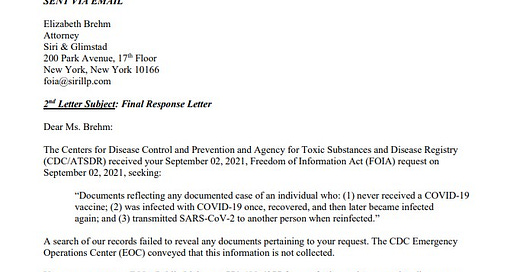The Argument Over Natural Immunity is Over. It's Time to Update Policy.
Science shows robust and durable T-cell immunity to variants. Now, CDC admits no record of unvaccinated person who had COVID-19 spreading.
At one time, there was a great amount of concern of people who had COVID-19 being re-infected and getting sick again.
Public health policies, including the rationalization of universal vaccination with endless boosters, and OSHA’s recent and highly challenged universal administrative rule, have been based on the theoretical possibility that those with past COVID-19 infections may still spread the SARS-CoV-2 virus, but evidence on viral escape from natural immunity has been scarce.
By contrast, a study in Genomics published in July, 2021 found Vaccine Escape and Vaccine-Weakening mutations in the receptor binding domain of the SARS-CoV-2 virus (See “Vaccine-escape and fast-growing mutations in the…”).
The theoretical concern over escape from infection is comparatively weak. A study in PNAS predicted that SARS-CoV-2 would evolve to escape polyclonal antibodies produced against the viral proteins during infection (See SARS-CoV-2 escape from a highly neutralizing COVID-19 convalescent plasma). This theoretical analysis reported that “only three mutations were necessary” for the virus to escape infection-acquired immunity to existing immunity to the spike protein. The study did not provide any probability of such escape happening and failed to distinguish between polyclonal immunity to multiple proteins, as happens in SARS-CoV-2 infection, and immunity to the single spike protein, which may occur in persons who have had mRNA vaccines.
Public health policies have been based on the premise that natural immunity does not play an important role in protecting individuals. OSHA’s recent administrative rule requires that those who have survived COVID-19 still need to vaccinate, or test & mask due to OSHA’s concern over accuracy of tests for immunity. (Ironically, OSHA shows no concern over accuracy of the use of PCR tests for case discernment, a problem that has long been recognized by scientists around the globe).
All of that changed this week when The Gateway Pundit shared the contents of a letter, obtained via FOIA from the US CDC admitting that they have no record of anyone who has recovered from SARS-CoV-2 infection spreading the virus post-recovery.
From Pundit:
“The CDC admitted it has no record of an unvaccinated person spreading Covid after recovering from Covid in response to an attorney’s FOIA request.
A New York attorney filed a FOIA request in September asking for “documents reflecting any documented case of an individual who (1) never received a Covid-19 vaccine; (2) was infected with Covid-19 once, recovered, and then later became infected again; and (3) transmitted SARS CoV-2 to another person when reinfected.”
The CDC responded: ‘A search of our records failed to reveal any documents pertaining to your request. The CDC Emergency Operation Center (EOC) conveyed that this information is not collected.’”
The Pundit article includes a Tweet linking to the CDC’s response letter, as well as a Tweet from Senator Rand Paul that mentions this peer-reviewed study published in the journal Open Forum Infectious Diseases.
Oddly, the Pubmed database labels this study as a “Preprint”, while clearly (from the publisher’s website) it has now survived peer review.
Long-term immunity to the SARS-CoV-2 virus is expected following COVID-19 infection given the large number of immunogenic epitopes present in the proteome of the virus. In April 2020, I published an analysis (validated by Harvard University) in which I identified over 50 epitopes in the SARS-CoV-2 proteome (See: Pathogenic priming likely contributes to serious and critical illness and mortality in COVID-19 via autoimmunity).
The SARS-CoV-2 vaccines from Moderna and Pfizer target one protein. This has led to grave concern over “vaccine escape”. One article in The Lancet predicted vaccine escape within six months if the number of cases remains too high (See SARS-CoV-2 incidence and vaccine escape). The madness of mass vaccination during an epidemic was known; if the vaccine is imperfect (i.e,, “leaky”), vaccine escape is all but assured. Vaccine efficacy has plummeted, and is now likely below 50% for all three vaccines in use in the US (See Do COVID-19 Vaccines Still Qualify for Emergency Use Authorization?)
Broad and Durable beats Narrow and Temporary
A longitudinal study in Cell Reports Medicine followed 254 patients with mostly mild to moderate symptoms of SARS-CoV-2 infection over a period for more than eight months (250 days). The study authors reported that the patients’ immune responses to the virus remained durable and strong. (See Longitudinal analysis shows durable and broad immune memory after SARS-CoV-2 infection with persisting antibody responses and memory B and T cells).
Studies reporting durable immunity from vaccines are less reassuring, as the vaccination program does not provide redundant immunity due to polyclonal antibodies to the myriad immunogenic epitopes provided by SARS-CoV-2 infection.
If public health policy in the US were at all science-based, those who have B- and T-cells would be exempt from vaccination, masking, social distancing and should not have their livelihoods threatened by administrative rules agnostic to the on-the-ground, real-world and peer-review data.





I think the main danger from covid is its spike protein. Most people will get less spike from natural infection than from the vaccines, so for most people natural infection is safer. Vaccinating already-immune people is irrational, because it just increases toxic spike exposure.
I suspect that the high excess deaths in the US in both 2020 and 2021 were caused by spike exposure: in 2020 from covid cases that were not immediately fatal, but caused latent injury, and in 2021 from covid cases plus vaccine-induced spike. 2021 excess deaths are much higher than 2020, which reflects much higher spike exposure from vaccines. https://www.usmortality.com/excess
The major failing in our pandemic response has been delayed treatment until hospitalization. Early treatment will almost always reduce spike exposure, and thus reduce overall excess death rates.